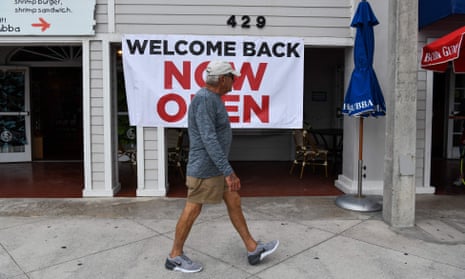Donald Trump was quick to celebrate the US Department of Labor’s monthly job report on Thursday after it revealed a record 4.8m jobs came back in June as states reopened following coronavirus lockdowns.
But while the White House has already boasted the report is a sign of successful economic recovery, the reality is that millions of Americans are still indefinitely out of work. And to make things worse, the report gets its data from a survey that was administered in the earlier half of June, before states such as California, Arizona and Texas reversed the reopening of businesses like gyms and bars in the wake of huge surges of new Covid-19 infections.
Here are a few takeaways from today’s report, which shows many are still suffering the consequences of the pandemic’s recession and the economy is far from out of the woods.
1 The racial unemployment gap has worsened
Economists have long said that during recessions, black Americans are susceptible to the “last hired, first fired” phenomenon due to systemic racism and job segregation. June’s job report showed that this pandemic-induced recession is not different.
Even as Black Lives Matter protests ignited a reckoning on racism in the aftermath of the police killing of George Floyd in Minneapolis, black Americans have experienced the slowest recovery of all racial groups.
Though the past three months have brought an over 3% decrease in the overall unemployment rate, the black unemployment rate has seen a much slower recovery rate.
The black unemployment rate reached its peak in May at 16.8%. In June, the rate went down to 15.4%. Comparatively, the white unemployment rate went from its peak of 14.2% in April to 10.1% in June. While Hispanic Americans had the highest unemployment rate of any racial group over the past three months: hitting 18.9% in April, the Hispanic unemployment rate dropped to 14.5% in June.
2 State and local government jobs are still gone
Responding to the pandemic has completely dried up the budget for local governments across the US. Estimates report that local governments will face a cumulative deficit of $615bn this year because of the pandemic.
June’s job report further confirmed that state and local governments are in deep trouble. Government jobs went down a total of 1.5m in April and May, and in June, just 33,000 of those jobs have been recovered.
In comparison, other hard-hit industries have seen huge recoveries. Leisure and hospitality and retail, for example, gained 2m and 740,000 jobs in June, respectively. While millions of people are still out of jobs in those industries, the report reveals that reopenings are effective in bringing those jobs back slowly. With state and local governments, the benefits are still uncertain.
State gov't employment a conspicuous outlier, down 25K jobs in June w/ no trend reversal thus far. Very important re deliberations over state fiscal relief. pic.twitter.com/NDXTev6fOj
— Jared Bernstein (@econjared) July 2, 2020
3 Americans continued to drop out of the labor force
Even as states started reopening, and millions of jobs were coming back, more Americans were reported as “discouraged workers” – Americans who are able to work but have given up looking for a job – than in any previous month during the pandemic.
The number of discouraged workers increased from 574,000 Americans in April to 681,000 Americans in June. In comparison, 427,000 Americans were discouraged workers in June 2019.
4 The unemployment rate for women is still higher than the men’s rate
Over the last three months, women have had a higher unemployment rate than men, though the gap has been shrinking.
In April, the unemployment rate for women was 15.5% – higher than the national average of 14.7% – while men had an unemployment rate of 13%. While both male and female workers saw a decrease in unemployment in June, reaching 10.2% and 11.2%, respectively, the gap still remains. In comparison, men and women had the same unemployment rate in June 2019.
The gap is largely due to shutdown orders disproportionately affecting occupations that are mostly held by women, such as housekeeping and restaurant hostesses.
Unemployment is hitting women hard than men in this recession, and for Black and Hispanic women, unemployment rates are extremely high. The unemployment rate is 14.6% for Black women and 16.1% for Hispanic women. 14/
— Heidi Shierholz (@hshierholz) July 2, 2020
5 About a third of jobs have come back
May and June have brought back about 7.5m jobs, but most of the 22m jobs that were lost in March and April have not come back.
Economists warn that as new Covid-19 cases surge in dozens of states, economies will once again be hit by renewed shutdown orders that June’s report did not capture. Thus, in hindsight, June’s report may be the best one to come.
